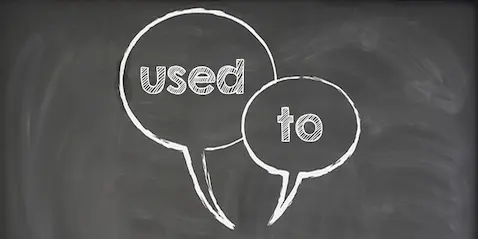Let’s start with the main aim of the lesson and how we’ll know if this aim has been achieved:
Main aim
To develop students’ ability to talk about past habits using “used to” in the context of childhood and addictions.
We’ll know if this has been achieved if, during the less restricted practice stage, students use used to to talk about past habits with a partner.
Materials
Here’s what we’ll need:
- Some pictures of chocolate, cigarettes and coffee or, even better, some chocolate, cigarettes and coffee!
- Some pictures (or if you have the time to find them, very short video clips) of children doing typical children-like activities, like playing on the swings, dressing up for Halloween or studying at school.
- A listening text of people talking about their addictions. Language To Go Intermediate (Longman, 2002, Crace & Wileman) lesson 11 has a very good text. If you don’t have access to this, try recording your own – ask 3 or 4 friends to each talk for a minute about an addiction, whether they’ve given it up, and if so, when/how/etc.
The lesson
Okay, on to the lesson itself. Here are the different stages with the aim of each stage, the approximate timing, and what to do:
Lead in
To set the context and generate interest (10 minutes)
Stick some photos on the wall around the classroom of children doing children-like things (or play short video clips if you have them). Have students in pairs look at the photos and discuss whether or not they did these things in the past and whether or not they do them now. Feedback on this from a few students. Next, ask the students to write down 3 things that they themselves did in the past but don’t do now. Give them a couple of minutes to think about it and write, and then collect the pieces of paper and keep them – you’ll need them for later on in the lesson.
Lexis
To introduce lexis for the listening stage which follows (10-12 minutes)
Show the students your pictures of coffee, cigarettes and chocolate (or your actual coffee, cigarettes and chocolate) and have them discuss, in pairs or small groups, whether or not they use these things, how often, and whether or not they can stop using them if they want to. During feedback to this activity elicit or present vocabulary items that students may be unfamiliar with in the listening text. In the text from Language To Go, for example, you might want to elicit addict, addicted, addiction, to quit, to give up, to cut down on and willpower.
Listening
To practise listening for gist (10-12 minutes)
As well as providing the context for the presentation of the target language, this stage has a subsidiary aim of developing students’ ability to listen for gist. Students listen to 4 people (or if you’ve recorded it yourself, however many friends you managed to record) describing their addictions. Set the following gist questions before they listen:
- What are they addicted to?
- Have they given up?
- Are they addicted to the same things as you? (This last one personalises the activity)
Feedback this activity on the board.
Presentation
To introduce the target language and manipulate the form (8-10 minutes)
Using your feedback from the listening activity, elicit or present the target language with the following concept questions, changing the addiction that you ask about depending on the recording you used:
- Did he smoke in the past? (Yes)
- Once or many times? (Many times)
- Does he smoke now? (No)
Target language: He used to smoke.
Repeat this with the other examples and then elicit or present the negative and question forms.
(See our used to grammar guide for more examples in context.)
Restricted practice
To provide restricted practice in using the target language, standardise pronunciation and provide a written record (2-4 minutes)
Drill the target language, including the negative and question forms, focusing on the weak form of to, for example: “He /juːstə/ smoke.” Write the affirmative, negative and question forms on the board to give students a written record of the target language.
Less restricted practice
To give students less restricted practice in using the target language (10-12 mniutes)
Now it’s time to bring the lesson full circle and come back to the childhood activities that you asked the students to write at the end of the lead-in. Take the pieces of paper you collected earlier and write on the board one activity form each student. they wrote three, so you should have a range of different activities, including, with luck, some funny or unusual ones. Don’t stick the pieces of paper directly on the board or your students may recognise the handwriting, which will defeat the object of the activity. Now have students circulate, asking each other questions using the target language to find out who used to do what. Monitor and encourage them to ask follow-up questions to expand the conversation beyond the limited use of the target language. Feedback the activity by asking a few students what they found out.
That’s it. You can see the full lesson plan in a table format here.
Any comments, or suggestions of other ways to teach used to are welcome below…








18 comments
oumar ba
I personally found this way of teaching very communicative. ESLBASE.COM for ever. You always update language teachers on challenging ways and techniques as to how to go about foreign language teaching in a communicative approach. Cheers once again!!!!!!!!!!!!!!
Arif
thanks a lot for the way you have presented this lesson. I’ll try it with my learners. Thanks again.
halima
thanks a lot…….but where is the listening script,please?
Buray
https://tr.scribd.com/document/27303420/Language-to-Go-Intermediate-Recording-Scripts :)
Keith Taylor
Hi Halima
The listening text I use is from Language To Go Intermediate (Longman, 2002) but this is copyrighted material so we can’t include it here. You could try recording your own script – ask 3 or 4 friends to each talk for a minute about an addiction, whether they’ve given it up, and if so, when/how/etc.
Hope that helps!
Maria
Wonderful plan, thanks a lot! It’s the first time I enter the site and it’s really useful
Keith Taylor
Thanks Maria, glad you find the site useful!
Leonel
Very well presented. Totally inspires… :D
Keith Taylor
Thanks Leonel!
Sarah Azad
Thank you! Always good to find new and interesting ideas.
Heberth
Please, I need some help!
When do I use:
I used to smoking cigarretes. (used to +ing)
I used to work as an intern (used to + verb in the infinitive) ?
Is there a difference? I still did not find anything about it.
Thank you in advance.
Keith Taylor
Hi Heberth
“I used to smoking cigarettes”.
This is not correct so we never use this.
But…
We can say “I AM used to smoking cigarettes”. This has a different meaning – please see https://www.eslbase.com/grammar/get-used-to for more on the meaning of this.
“I used to work as an intern”.
This is correct. It means that you worked as an intern in the past, but you don’t now. See https://www.eslbase.com/grammar/used-to for more about the meaning of this.
Hope that helps.
RABAB
GREAT VERY HELPFUL THANKS
Bec
Many thanks!!
Jennifer Herrera Molina
Great lesson plan! Thanks for sharing.
Dil
Great lesson. Thanks for sharing. My class is two hours long so I’ll have them form groups (they’re 30 students) and role play a AA meeting. Thanks for the ideas
HAS English Center
thank you
Mia Faricha
Thank you for sharing, this is a great lesson plan, I can understand more about the lesson plan. Very helpful.